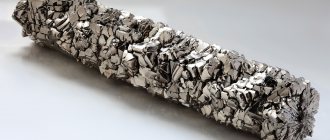Polymers are high molecular weight chemical compounds (HMCs), the macromolecules of which are formed from many monomer units. Polymer molecules are characterized by a huge molecular weight, from several thousand to several million atomic mass units . There are several options for classifying polymers.
- Based on their chemical composition, polymers are divided into organic ( polyethylene ), inorganic (silicates) and organoelement ( fluoroplastic-4) .
- Depending on their origin, polymers are natural, artificial (modified) and synthetic.
- The classification of polymers according to the composition of their monomer units divides polymers into homopolymers and heteropolymers (or copolymers).
- Depending on the structure of the main chain, homochain and heterochain polymers are distinguished.
- Based on the spatial structure of monomer units , polymers are divided into stereoregular and nonstereoregular (or atactic).
- According to the structure of macromolecules, polymers are divided into: linear, branched, ladder and three-dimensional cross-linked (mesh, spatial).
- Depending on the production reaction, polymers are also divided into polymerization and polycondensation.
- The classification of polymers in relation to temperature effects is of important practical importance. In relation to heating allocate thermoplastic (polyethylene, polyvinyl chloride, polystyrene) And thermosetting polymers (epoxy resins).
What is a polymer?
Polymers are high-molecular chemical compounds (HMCs), substances with a molecular weight from thousands to several million atomic units.
Polymer macromolecules are formed from a huge number of repeating monomer units. The properties of polymers depend on the chemical nature of the monomer, molecular weight, the method of polymer production, the stereostructure of the molecules (location in space) and the degree of their branching, as well as the bonds between molecules of different natures. Most polymers are dielectric in nature, also have low thermal conductivity and fairly high mechanical characteristics.
Concept of polymers
Polymer. What it is? You can answer from different points of view. On the one hand, it is a modern material used to make many household and technical items.
On the other hand, we can say that it is a specially synthesized synthetic substance obtained with predetermined properties for use in a wide specialization.
Each of these definitions is correct, only the first from a household point of view, and the second from a chemical point of view. Another chemical definition is the following. Polymers are macromolecular compounds based on short sections of the molecular chain - monomers. They are repeated many times, forming a polymer macrochain. Monomers can be both organic and inorganic compounds.
Therefore, the question: “polymer – what is it?” – requires a detailed answer and consideration of all properties and areas of application of these substances.
Classification of polymers
Dividing polymers into distinct classes is a rather complicated matter. In modern theory, there are several divisions of polymer materials by type:
- polymers can be natural or synthetic, there are also modified polymers;
- Based on the type of formation reaction, polymers are divided into polymerization and polycondensation;
- Depending on the chemical composition, polymers are divided into inorganic (for example, silicones), organic polymers (for example, polystyrene) and organoelement polymers (for example, fluoroplastics). In this case, the main type of polymers used is organic;
- Based on the processing method and the corresponding relationship to the effects of temperature on them, polymers are divided into thermoplastics (thermoplastics) and thermosets (thermosets). The former are capable of being recycled many times, the latter, as a rule, are not;
- Based on the composition of monomer units, polymers are divided into homopolymers and copolymers (heteropolymers);
- polymers are also divided according to the structure of the main chain into homochain and heterochain, according to the spatial arrangement of monomer units into stereoregular and atactic (non-stereoregular), according to the degree of branching into linear, branched, ladder and cross-linked, etc.
Rice. 1 Polymer structure
Types of polymers
There are many classifications of polymers according to various criteria (chemical nature, heat resistance, chain structure, and so on).
In the table below we briefly consider the main types of polymers. Classification of polymers
| Principle | Kinds | Definition | Examples |
| By origin (appearance) | Natural (natural) | Those that occur naturally, in nature. Created by nature. | DNA, RNA, proteins, starch, amber, silk, cellulose, natural rubber |
| Synthetic | Obtained in laboratory conditions by humans, have no relation to nature. | PVC, polyethylene, phenol-formaldehyde resins, polypropylene, polyurethane and others | |
| Artificial | Created by man in laboratory conditions, but based on natural polymers. | Celluloid, cellulose acetate, nitrocellulose | |
| From a chemical point of view | Organic nature | Most of all known polymers. It is based on a monomer of organic matter (consists of C atoms, possibly including N, S, O, P and others atoms). | All synthetic polymers |
| Inorganic nature | The basis is elements such as Si, Ge, O, P, S, H and others. Properties of polymers: they are not elastic, do not form macrochains. | Polysilanes, polydichlorophosphazene, polygermanes, polysilicic acids | |
| Organoelement nature | A mixture of organic and inorganic polymers. The main chain is inorganic, the side chains are organic. | Polysiloxanes, polycarboxylates, polyorganocyclophosphazenes. | |
| Main chain difference | Homochain | The main chain is either carbon or silicon. | Polysilanes, polystyrene, polyethylene and others. |
| Heterochain | The main skeleton is made up of different atoms. | Examples of polymers are polyamides, proteins, ethylene glycol. |
There are also polymers of linear, network and branched structure. The basis of polymers allows them to be thermoplastic or thermosetting. They also differ in their ability to deform under normal conditions.
Polymer formation
In nature, biological polymers or biopolymers are obtained naturally during the life processes of plant and animal organisms. Artificial polymers are usually produced by petrochemical and gas chemical enterprises through two main types of chemical reactions: polymerization and polycondensation
Polymerization is the process of synthesizing a polymer by attaching repeating chains of molecules (units) of a monomer to the active growth center of a macromolecule of a high-molecular compound. In a simplified form, the polymerization mechanism can be described in the following stages:
- formation of polymerization centers;
- growth of polymer macromolecules upon addition of successive units;
- the emergence of new polymerization centers on other molecules and their intensive growth;
- the appearance of branched polymer molecules;
- cessation of growth of macromolecules.
Typically, polymerization does not occur under normal conditions. To begin the chemical process of polymerization, low-molecular raw materials are exposed to a variety of methods depending on each specific technical process: exposure to light or other type of irradiation, increased pressure, high temperatures. At the same time, the most efficient process occurs in the medium of a catalyst, which is individually selected for each specific process for obtaining a specific polymer. When polymers are formed by polymerization, no by-products of the reaction are released; the chemical composition of the substances remains unchanged, but the structure of the bonds in the substance changes.
Rice. 2 Polyethylene production plant
Polycondensation
is the process of synthesizing polymers from low molecular weight substances using rearrangement of atoms to release polycondensation by-products. These can be various low-molecular compounds, such as water. The polycondensation method is used to produce large-capacity polymers such as polyurethanes, polycarbonates, and phenolic resins.
Polymer production
Polymer. What it is? This is practically everything that surrounds us. Where are they made?
- Petrochemical (oil refining) industry.
- Special plants for the production of polymer materials and products made from them.
These are the main bases on the basis of which polymer materials are obtained (synthesized).
Basic properties of polymers
The structure of macromolecules in the form of a chain, as well as the various types of bonds between them that arose during the formation of molecules, determine the nature of the special physicochemical characteristics of polymers. Among them, an important feature is film and fiber formation, the ability of polymers to be drawn, strength in certain directions, elasticity, etc. This structure of polymer molecules determines the fact that the viscosity of polymer solutions is usually high. IUDs can swell to a high degree in liquids, while forming several types of systems whose properties are between solid-liquid states of aggregation.
The number of monomer units in polymer macromolecules and the nature of the unit determine the molecular weight of the entire BMC. Any polymer always consists of many macromolecules, each of which is individual and differs from the others, including in chain length. Because of this fact, the molecular weight of polymers is always an approximate average value. It also follows from what has been described that an important characteristic is the molecular weight distribution (MWD), which shows in what range of molecular weights the molecules are present in a particular polymer sample. The smaller the molecular weight distribution, the more stable the properties of the polymers and the easier it is to describe the methods of their processing.
Polymers can be in several states of aggregation, which differ from the states of ordinary low-molecular substances, for example, in the state of a viscous fluid, elastic state, such as rubber, silicone, other elastomers, and hard plastics.
Application of polymers
It is difficult to overestimate the importance of polymers from the point of view of their practical application. In the modern world there is practically no sphere of human life and society, science and business where at least one type of polymer is not used.
Polymer materials are most actively used in the production of cars, machinery and equipment; in the aviation and aerospace industries; in the industry of development and creation of medical devices and equipment. Let us dwell on some of the areas of practical use of polymer materials in more detail.
Application of polymers in the automotive industry
Main article: Polymers in the automotive industry
The reliability of a modern car, the durability and comfort of its operation, as well as (what is important) the safety of movement can only be ensured if polymer materials - plastics, rubbers, varnishes and paints , etc.
Plastics are used to make car bodies and cabins and their individual large-sized parts, various small-sized parts for structural and decorative purposes, heat-insulating and sound-proofing parts, etc.
among the most important and most material-intensive rubber products for the automotive industry . Numerous rubber products are also of great importance in this industry, the quality of which largely determines the reliability of the vehicle.
Paint and varnish materials used for priming and final finishing of metal surfaces must form coatings that reliably protect the metal from corrosion (see Protective paint and varnish coatings) and have high hardness, elasticity, impact resistance, heat and wear resistance.
Application of polymers in aircraft construction
Main article: Polymers in aircraft manufacturing
Another large-scale area of practical application of a wide range of polymer materials is the industry of development, production and operation of aircraft.
The feasibility of using polymers in this direction is due to their lightness, variability of composition and structure, and, consequently, a wide range of technical properties. The tendency to expand the boundaries of the use of polymer materials is also typical for the production of rockets and spacecraft.
Main polymers and segments of use:
- Thermosets;
- Thermoplastics;
- Foam plastics and honeycomb plastics;
- Rubber;
- Sealants and adhesives;
- Paints and varnishes.
You will find detailed information on the use of polymers for these segments in the aircraft industry in the main article, the link to which is indicated at the beginning of the paragraph.
Application of polymers in mechanical engineering
Main article: Application of polymers in mechanical engineering
Perhaps one of the key areas for the use of polymers and materials based on them is mechanical engineering. For example, the consumption of plastics in this industry is already becoming comparable (in units of volume) with the consumption of steel. Analysts note that the use of paints and varnishes, synthetic fibers, adhesives, rubber and simple substances and polymer-based materials is also continuously increasing.
The feasibility of using polymers in mechanical engineering is determined, first of all, by the possibility of reducing the cost of products. At the same time, the most important technical and economic parameters of the machines are also improved: weight is reduced, durability, reliability and other essential properties are increased.
Application of polymers in medicine
Main article: Polymers in medicine
Due to the wide range of properties and physical and chemical characteristics of the resulting products, polymers and materials based on them have found wide application in medicine.
The use of polymer materials for the manufacture of products and equipment for medical purposes allows for the serial production of instruments, patient care items, special utensils and various types of packaging for medicines, which have a number of advantages over similar products made of metals and glass: cost-effectiveness, and in some cases increased durability to exposure to various environments, the ability to produce disposable products, etc.
Particular attention should be paid to the issue of the use of polymer materials in pharmacology . The role of this category of materials in the pharmacological aspect is still relatively small. They are rarely used in medical practice. Naturally, very stringent requirements are imposed on substances introduced into the body, especially those that must enter the blood, lymph, intercellular and cellular cavities in dissolved form and can reach any part of the body, any of its receptors.
It is also worthwhile to dwell separately on the issue of the practical use of polymer materials in such a medical segment as surgery . Taking into account the properties of the resulting products, polymer materials are actively used in several segments of modern surgery:
- Reconstructive surgery;
- Cardiovascular surgery;
- Surgery of internal organs and tissues;
- Traumatology and orthopedics;
- The use of polymers in functional units of surgical devices.
In conclusion, we note that polymers in the medical aspect are also used in the creation of blood substitutes and plasma substitutes .
Application of polymers in the food industry
Main article: Polymers in the food industry
Perhaps the most well-known issue for the mass consumer is the issue of using polymers for the needs of the food industry.
It should be noted that polymers in the food industry must meet a set of certain sanitary and hygienic requirements due to the contact of these materials with food. A mandatory condition for the use of polymer materials in the food industry is permission from sanitary inspection authorities, which is issued on the basis of a set of tests, including assessment of organoleptic properties, as well as sanitary-chemical and toxicological studies of polymers and individual ingredients included in composite materials and products.
Among the largest consumers of polymer materials in the food industry are “food engineering” and the production of containers and packaging for storing and transporting food products. Moreover, in the latter case, polymers can act both as the main material (for example, plastic bottles), and as auxiliary elements and additives designed (for example) to protect a metal container from corrosion.
Types of polymer processing into products
Although in everyday life the term "plastics recycling" is used to mean the collection and recycling of products from already used plastic, in fact the term has a slightly different meaning. Polymer processing refers to the production of finished products from previously synthesized polymers, including primary ones.
Polymer processing typically occurs at high temperatures ranging from 150 to 500 degrees Celsius depending on the nature of the particular polymer. The exception is some thermoset plastics, such as two-part epoxies or polyurethane foams, which react at room temperature. During processing, various additives can be added to the polymer (in the case of, for example, PVC, which is not used as a pure substance, additives are practically required) for better processability, giving the plastic the desired properties or reducing the cost of the product. The most commonly used additives (additives for polymers) are, for example, fillers, dyes, stabilizers, plasticizers, modifiers, nucleators, etc.
Examples of products made from polymer materials
Before naming specific products made from polymers (it is impossible to list them all, there is too much variety), first you need to understand what the polymer provides. The material that is obtained from the Navy will be the basis for future products.
The main materials made from polymers are:
- plastics;
- polypropylenes;
- polyurethanes;
- polystyrenes;
- polyacrylates;
- phenol-formaldehyde resins;
- epoxy resins;
- nylons;
- viscose;
- nylons;
- polyester fibers;
- adhesives;
- films;
- tannins and others.
This is just a small list of the diversity that modern chemistry offers. Well, here it already becomes clear what objects and products are made from polymers - almost any household items, medicine and other areas (plastic windows, pipes, dishes, tools, furniture, toys, films, etc.).
Classification of polymers by area of application
Polymers, mainly thermoplastics, are divided according to the degree of increase in technical and operational characteristics. The main characteristic of the polymer is the temperature of long-term operation. In this case, polymers with known assumptions and quite large discrepancies among different authors are divided into three categories:
- General purpose plastics or polymers for general (general technical) purposes;
- Engineering plastics or construction plastics (polymers for engineering purposes);
- Super-engineering plastics or superstructural polymers.
Also playing an increasingly important role in the modern polymer industry is the class of elastomers or thermoplastic elastomers (TPE). In terms of their properties and methods of processing into products, these materials are similar to thermoplastics, while in appearance and performance properties they are close to rubber and caoutchouc. In everyday life, TPE is widely confused with rubber due to the ability of these materials to undergo significant reversible deformations.
Also, polymers and their grades are classified according to the most suitable processing method - injection molding, extrusion, press powder, etc.











